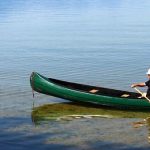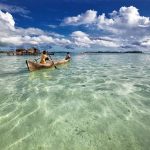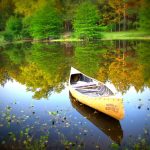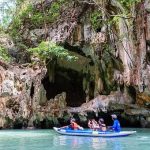Buying a canoe can be really exciting, but it can also be complicated and expensive. This is a purchase you want to get right the first time so you can enjoy years of paddling.
Today we will teach you how to buy a canoe that fits your specific size, preferences, and price range. We will also recommend some great whitewater canoes for beginners to experienced paddlers.
How To Choose A Canoe For Whitewater
You have your typical recreational canoe, your whitewater canoe, and your river running canoe. Ideally, you want a whitewater canoe if you’re going to be spending most of your time on rivers with Class III and IV rapids.
There are three different types of canoes – recreational, whitewater, and river running. You want a whitewater canoe if you’re going to be spending most of your time on rivers with Class III and IV rapids.
The Different Types Of Canoes
The primary step in purchasing a canoe is figuring out which of the main styles is most appropriate for you. To answer this question, take into account your experience level and objectives. The type of water you’ll mostly paddle in is also relevant.
Given that you’re here to learn how to buy a canoe specifically for whitewater, you’ll probably be most keen on a river canoe. Let’s breakdown the main styles currently on the market:
Tripping Canoes
The following text is about canoes that are designed for overnight trips, which are called “tripping” canoes or sometimes wilderness canoes.
These canoes have the capability of hauling more gear than other styles, but they don’t perform as well when not weighed down. They’re typically designed for multiple people to paddle at once.
Sporting/Racing Canoes
Canoes built for speed are much narrower and longer than other styles, unless your goal is to paddle as fast as possible.
Recreational Canoes
Recreational canoes are good for people who only want to take their canoe out to the lake for some relaxing paddling and fishing.
They are steady, maneuverable, and easy to control. Sometimes these canoes are referred to as ‘cabin’ canoes because they are optimized for the lake house.
River Canoes
Whitewater canoeing can be a treacherous activity, so it is important to have a canoe that is designed for such conditions. These types of canoes offer maximum maneuverability, which is necessary for making sharp turns and moving laterally.
Many of them are also outfitted with spray skirts to keep the water out.
Multi-purpose Canoes
Canoes that can do a little bit of everything are called multi-purpose canoes. They are designed to handle all sorts of water and activities, from gentle lakes to whitewater rapids.
While they may not be great at any one paddling style, they are perfect for beginners who want to learn how to paddle in different types of water.
Which of These Is Best for Whitewater?
The best canoe for paddling in a whitewater river is a river canoe. They are more maneuverable, impact-resistant and abrasion-resistant.
Consider The Ideal Whitewater Canoe Size
What size whitewater river canoe should you get? There are just a few factors to consider when sizing your canoe:
Length
The length of a canoe affects how fast you can paddle it and how easily it can be maneuvered. For river floating, speed is not as important as it is for other activities because the current will help push you along.
Most canoes are between 13 and 20 feet long. If you are going to paddle alone or with someone else, this will affect the size of canoe you want. If you want a canoe that can be used for both solo and tandem paddling, then you should stick with a canoe that is 15-18 feet long.
We personally love canoes that are right around 15 feet long for river paddling.
Width
Extra width means extra stability in a canoe. When you’re on the river, you’ll want a stable canoe to avoid tipping over.
Narrowboats are more likely to tip than wider canoes, so it’s best to choose a canoe that is at least 37″ wide.
Some of the best whitewater canoes are even wider than 40″.
Depth
This text speaks about the distance between the top of your canoe’s side rails and the bottom. The deeper the boat, the less water will splash in.
However, the canoe is more susceptible to wind interference.
Which Canoe Is Best for Me?
There are many different types of canoes that would be great for this style of paddling, but we recommend the Grabner Inflatable Canoes. They are a great choice for anyone, whether you are buying your first canoe or upgrading from your current boat.
These boats outperform other styles in whitewater and are also great for lazy days paddling through calm water. They are portable, durable, and easy to repair, and continue to win awards for their performance.
How to Buy a Canoe
Lingo
may be padded for extra comfort. First, the basic parts. The front end of a canoe is the bow, the back end is the stern.
Every canoe has top edges, or gunwales (pronounced GUNnels), which are made of vinyl (durable, economical, and quiet when bumped with your paddle), wood (sometimes lighter, generally prettier, and requiring higher maintenance), or aluminum (tough and flexible).
Thwarts are crosspieces that add rigidity and serve as attachment points for yokes, seat supports, and gear tie-ins. Seats, in a variety of materials, affect comfort and stability.
Some flatwater models have “tractor seats,” which are often designed to slide back and forth for optimum trim adjustment. They may be padded for extra comfort.
Design
Length is the most distinguishing design feature of a canoe. Canoes can be as short as 10 feet or as long as 23 feet. The length of a canoe affects how well it turns and how well it tracks.
A shorter canoe is better for turning, while a longer canoe is better for tracking. A wider canoe is more stable, but it does not track as well.
The shapes of the bow and stern, called the stem, affect the way a canoe moves through the water. A vertical stem slices cleanly and maximizes the boat’s length in the water, meaning the canoe will track well and have excellent resistance to sidewinds.
However, this design also reduces the canoe’s ability to spin quickly and may make it ride lower in the water, causing it to be wetter in waves. Stems can also be designed with a curve that goes backward (recurved) or forward (raked).
A more rounded stem increases the canoe’s ability to ride up and over waves but doesn’t track as effortlessly. You may also hear references to high- and low-volume bows, which refer to how much of the canoe is above the water.
Then look at the canoe from the side, so you can see its outline. Is it always parallel to the waterline, or does it flare outward at the top? This is the sheer.
More flare means more initial stability—the craft is less likely to capsize—with the downside of more windage and less speed. Next, take a look at the canoe from the front. Is the bow and stern higher than the center, or lower, or the same?
More rocker and more flare usually go together, but not always. First, take a look at the keel of the canoe. How much of it is touching the ground, and how much of it is curved up? This is called the rocker.
A canoe with more rocker will spin faster and ride better in waves, but it will be less stable and more vulnerable to the wind. Next, look at the canoe from the side. Is the bow and stern higher than the center, or lower, or the same?
More rocker and more flare usually go together, but not always.
Tumblehome is the term used to describe the way some canoes bulge inwards at the gunwales. This can vary from canoe to canoe. Tumblehome adds stability while still allowing a paddler to take efficient vertical strokes and can also aid in making turns when the boat is leaning sharply.
The transition between the bottom and sides of the canoe is called the “chine,” and it can be either “hard” and abrupt (giving the canoe a more “edgy” performance) or “soft” and smooth.
Together, chine and tumblehome affect many factors, including turning and “secondary stability,” or how the canoe handles when it is leaned.
Ask the Experts
You are now prepared to go shopping. We consulted some experts to assist you in making your decision with answers to some vital questions.
A: The first step a person should make when getting ready to buy a canoe is to identify the best design. To do this, they need to consider what type of canoeing they will be doing, how much gear they need to bring, and how many people will be using the canoe.
Once they have a good idea of what they need, they can start looking at different models and designs to find the best one for their needs.
B: The experts all agreed that the best way to decide which canoe to buy is to figure out how you plan to use it. This is because different canoes are better for different types of paddling, so you will have to sacrifice some features no matter what.
Some people buy boats that they realistically won’t be able to use often. For example, a tandem canoe requires having a regular partner to paddle with.
Other people might buy a boat for a future trip they want to go on, even though there’s no telling if that trip will ever actually happen.
The first thing that paddlers should consider is their location and what kind of paddling they want to do. According to Bob Taylor, most people use their boats within a one or two hour radius from their home.
What kind of paddling do you want to do? Big lakes, small lakes, whitewater rivers, or protected estuaries? If you live in the Midwest and want to do a lot of overnights in places with lakes and portages, you might want a longer, lighter canoe (17 to 18.5 feet) with a sharp entry and minimal rocker.
If you’re from the coastal Mid-Atlantic or Southeast and want to explore some of the region’s ledgy rivers and take your partner or kids into quiet estuaries of the Atlantic coast, you might want a 14- to 17-foot Royalex or polyethylene canoe with a bit of rocker and some volume in the bow.
When you are trying to decide which canoe to buy, keep asking yourself questions about what you want and need in a canoe. If you want a canoe that you can paddle either tandem or solo, many 14- to 16-footers will fit that bill.
However, if you are planning on long trips with lots of gear, you should make that at least 16 feet, preferably longer (18 feet is a common length for wilderness trippers). Also, if you are going to be paddling across big lakes, make sure your canoe is deep enough to not ship water if the waves whip up.
Additionally, if you are a small person, or do you have health concerns like back trouble that might keep you from lifting a heavy canoe, you should consider spending more money on a lighter canoe: if you can’t load it on the car, you aren’t likely to use it.
If you are having trouble figuring out your goals and expectations, the experts can help. Darren Bush of Rutabaga in Madison, Wisconsin, says that a good canoe salesperson will ask the right questions.
For example, he might ask if you are a serious cross-country skier or cyclist. If you are, then Bush knows that you have good balance and might be happier sacrificing some stability for a faster canoe.
Even if your friends and relatives are experienced, they may still have biases that don’t apply to you. Just because Uncle Harry loves his 15-foot duck-hunting canoe, that doesn’t mean it’s what you should buy.



